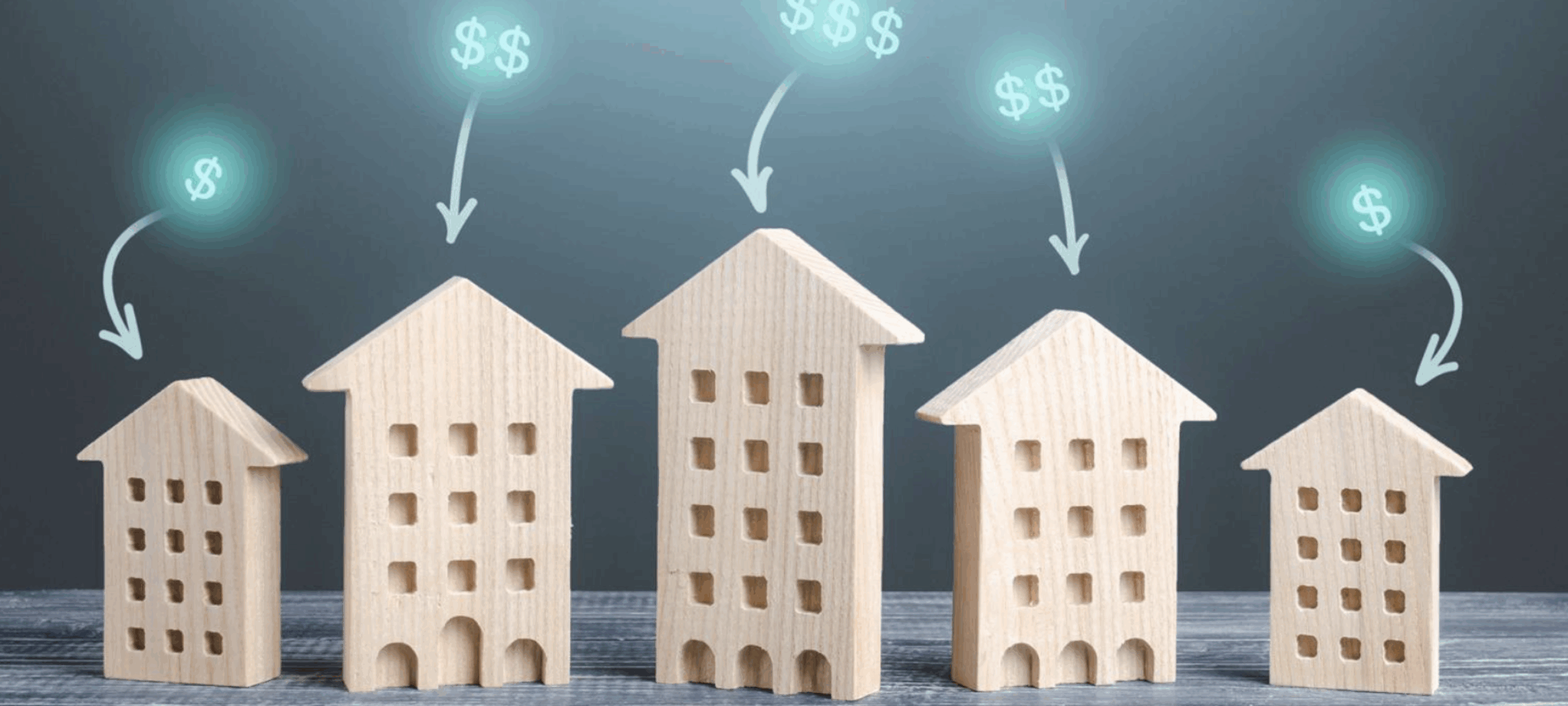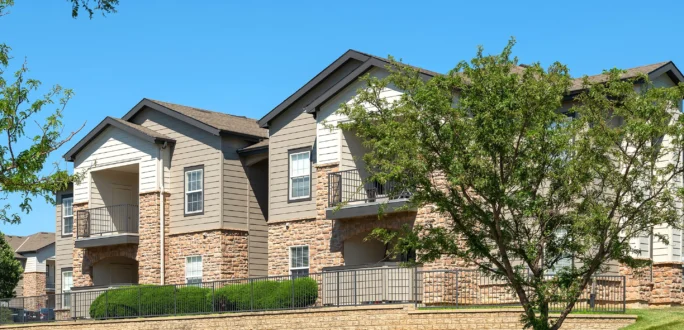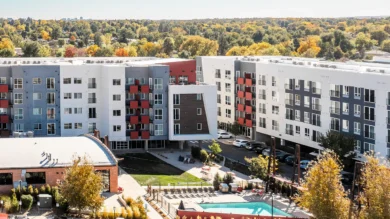
Why Multifamily Investments Are a Good Option When Inflation Runs Wild
 Why Multifamily Investments Are a Good Option When Inflation Runs Wild
Why Multifamily Investments Are a Good Option When Inflation Runs Wild
With stubborn inflation, investment triggers feel harder to pull in 2022. Multifamily real estate is a strong option.
In an inflationary environment, many investors flounder as pulling the trigger on investments of any kind can feel like higher stakes. The questions are endless. With rising interest rates, falling returns and concerns about recession, where are our dollars best placed to serve our long-term financial goals? Will I need to keep this cash more liquid in case inflation gets out of hand? Or what investments are safer when economics are shifting so rapidly all around us?
One particular category of investment is especially daunting to many, and even more so during shifting economic times—commercial real estate investing. In countless financial advisory offices this year, the question has been posed ‘is now a smart time to invest in commercial real estate?’
Our analysis points to yes, particularly when it comes to multifamily. Unlike stocks and bonds, real estate provides a strong defensive strategy against market volatility, a hedge against inflation and a wide range of tax advantages (especially in 2022). Additionally, the sector is currently benefitting from a fundamental imbalance in supply and demand, which is generating higher income and cash flows not available with other asset classes. Let’s take a closer look at the many factors at play.
Recession
There are several advantages of investing in multifamily real estate in a recessionary environment. Supply of both rental and for-sale housing is constrained, as lenders and equity partners have moved to the sidelines and new housing deliveries are delayed. Demand is increased, as renters are priced out of homeownership by exorbitant home costs and rising interest rates, and new cohorts join the rental market. Apartment occupancy rates also tend to remain firm during economic downturns, as renters are disinclined to relocate and opt to stay in the rental housing longer than they otherwise would.
Interest rates
Apartments are likely to perform well in both stable and rising interest rate environments. Historically, financing rates for apartments have been lower than other commercial property types, as federal backing of multifamily mortgages from Fannie Mae and Freddie Mac results in a lower risk premium than privately sourced mortgages. In fact, according to Real Capital Analytics, apartments have benefitted from financing rates that averaged more than 48 basis points lower than commercial property over the last 10 years. Apartment investors may actually benefit from demand destruction caused by higher interest rates—especially if the increase in rates is due to rising inflation, as is underway now. As homes become more expensive to buy, and new product more expensive to build, the existing inventory of rental housing becomes more valuable and in-demand.
Inflation
Multifamily investment can serve as a hedge against inflation by offering the opportunity to reset lease rates as frequently as every 12 months, compared to three to 10 years for other property types. This provides managers with the flexibility to quickly reset pricing to meet demand or offset rising operational costs.
Historically, apartment rents have tended to outpace overall inflation rates. However, the potential for pushing rents upward will vary by how cost-constrained each market is, so strong local knowledge and acquisition selectivity is essential.
RealPage recently published a study that found the vast majority of renters were able and willing to pay their rent. While rents have soared due to a 40-year high in inflation, so too have renters’ incomes. This has kept rent-to-income ratios much lower than widely assumed, and not enough to meaningfully change apartment affordability.
The benefits to apartment investors go beyond the dramatic increase in rents. At Hamilton Zanze, operating expenses for the company’s national portfolio of multifamily properties represent approximately 40 percent of revenue. Even though rents are rising faster than inflation, if both revenue and expenses rose at the rate of inflation, our net operating income (NOI) and cash flow would still increase.
Liquidity
Liquidity is the biggest factor differentiating multifamily from other types of commercial real estate right now. As capital markets have largely frozen up, it has become incredibly difficult to get a loan for an office building, for example. We predict we will see a significant amount of distress in these properties, which may provide opportunities for savvy investors. By contrast, there is plenty of liquidity for apartments, with government-backed lenders like Fannie Mae and Freddie Mac doing exactly what they are supposed to do—step up to provide liquidity to the nation’s residential mortgage finance system. As a result, apartments have been spared the dramatic drop in asset values we are currently seeing with other types of commercial real estate.
Tax benefits (especially in 2022)
Total returns on real estate investment are enhanced with several tax advantages, including depreciation (particularly with bonus depreciation through cost segregation), capital gains deferral through 1031 exchanges, as well as the tax-efficient cash flow to investors considered a return of capital and reduction of basis before becoming taxable.
Smart investors will want to act quickly in the fourth quarter to take advantage of bonus depreciation, which allows purchasers to deduct 100 percent of eligible property through December 2022. Beginning with acquisitions in 2023, this benefit will gradually decrease each year until it is phased out in 2026.
Portfolio diversification
As the world slowly reemerges from COVID and investors prepare for whatever lies ahead, it is important to remember that portfolio diversification is essential in uncertain economic times. Apartment properties can provide a proven alternative asset class to a well-constructed portfolio, and to a growing number of investors, the category is increasingly recognized as a “fourth asset class” and a valuable alternative to traditional investments such as stocks and bonds.
Valuations
Another question on investors’ minds right now is what is happening with valuations.
Capitalization rates (and therefore asset values) are largely influenced by capital flows—more so than interest rate movements. According to Dr. Peter Linneman, “the connection between both multifamily and office cap rates and interest rates is weak, while the connection with flow of funds is the powerful driving force.”
Currently, cap rates have expanded by 10-20 percent, as interest rates have caused many funds and private equity groups to sit on the sidelines. However, there is a tremendous amount of equity that needs to be deployed for apartments and we expect transactional volume will pick back up in the first quarter of 2023. As the flow of capital returns to the market, cap rates should begin to stabilize.
According to a new report from Freddie Mac, multifamily is well positioned despite pressure on cap rates, and they expect every market they cover to experience gross income gains this year. The reason for this is that while cap rates are influenced by risk appetites, perceived uncertainty, cost of capital and market upside, net operating income (NOI) is generated through operations. Consequently, NOI growth is eroding the decrease in valuation from cap rate expansion.
Demographic trends
Homeownership rates remain well below levels witnessed in the last recession and today’s demographic trends continue to favor renting. The prime age group for renters—typically those 20-34 years old—is still increasing in size. In fact, more than half of the nation’s total population are now members of the millennial generation or younger.
While millennials are getting older, many continue to rent, whether as a lifestyle choice or due to rising home prices and burdensome student loan debt. Gen Z has also now entered the rental housing market, which will have a significant impact in the years ahead. Additionally, due to lifestyle changes and down-sizing, baby boomers also continue to be a significant source of apartment demand.
High demand, limited supply
Despite recent increases in multifamily starts, demand for rental housing still far exceeds current supply with a shortfall of 600,000 units, as reported by the National Multifamily Housing Council and the National Apartment Association.
In recent years, apartment construction has been concentrated on class-A, “renter by choice” product in downtown or central business district (CBD) areas of the major gateway markets. This has reflected demand from young workers who prioritized prime location and amenities over living space, a preference that will likely shift as millennials seek larger, more suburban properties to start families. Developers have largely overlooked prime suburban areas, where rent and occupancy performance have outperformed downtown areas. This presents an opportunity for investors to acquire suburban apartments at more favorable initial acquisition yields.
There continues to be limited new development for properties targeted toward the more moderate “renters by necessity,” who are a stable source of demand and less likely to shift toward homeownership regardless of changing market conditions.
It is worth noting that current inflation is also impacting the upcoming supply of new multifamily product. The rising price of construction materials and labor costs may cause some planned projects not to be built and limit the development of future projects. This will have the effect of making existing product more valuable, as replacement costs increase.
Affordability gap
While rents have been rising sharply, home prices have risen even faster. As a result, renting remains a far more affordable option than buying almost everywhere. According to recent Zillow data, mortgage payments are higher than rent in 45 of the 50 largest U.S. metros, up from 22 in 2019. Typical U.S. rents are now $2,031 per month, having crossed the $2,000 threshold for the first time this year, with an annual growth rate more than three times that of July 2019.
As barriers to homeownership remain high, which will likely hold true for some time, renting remains the most cost-effective option for many would-be-buyers.
Pandemic impact
Counter to the assumptions of many, rent collections have remained generally stable throughout the pandemic—consistently averaging between 95 percent and 96 percent since March 2020, according to RealPage.
After rents were frozen for two years, landlords are now playing catch-up. Despite sharp rental rate increases in many markets, residents are staying in their apartments longer. According to RealPage, apartment retention rates rose by 3.5 percentage points year-over-year in April to 57 percent. Notably, when renters renew their leases, they are also spending significantly more—10.7 percent more when compared to their previous lease. New renters, however, are paying even higher rates for the same units.
Demand for rental housing continues to outpace inventory in many areas. The 2022 Rental Housing Report from the Joint Center for Housing Studies (JCHS) of Harvard University reported the lowest rental vacancy rates since the mid-1980s.
Conclusion
In summary, there are many compelling reasons for why now is a particularly good time to invest in multifamily real estate. Historic demand across multiple generations, an anemic supply of new housing, demographic and lifestyle trends that favor renting, and economic advantages for both investors and renters will continue to provide tailwinds to the multifamily market. It is, quite frankly, a great time to be a landlord in whatever form or fashion that role can be held.






